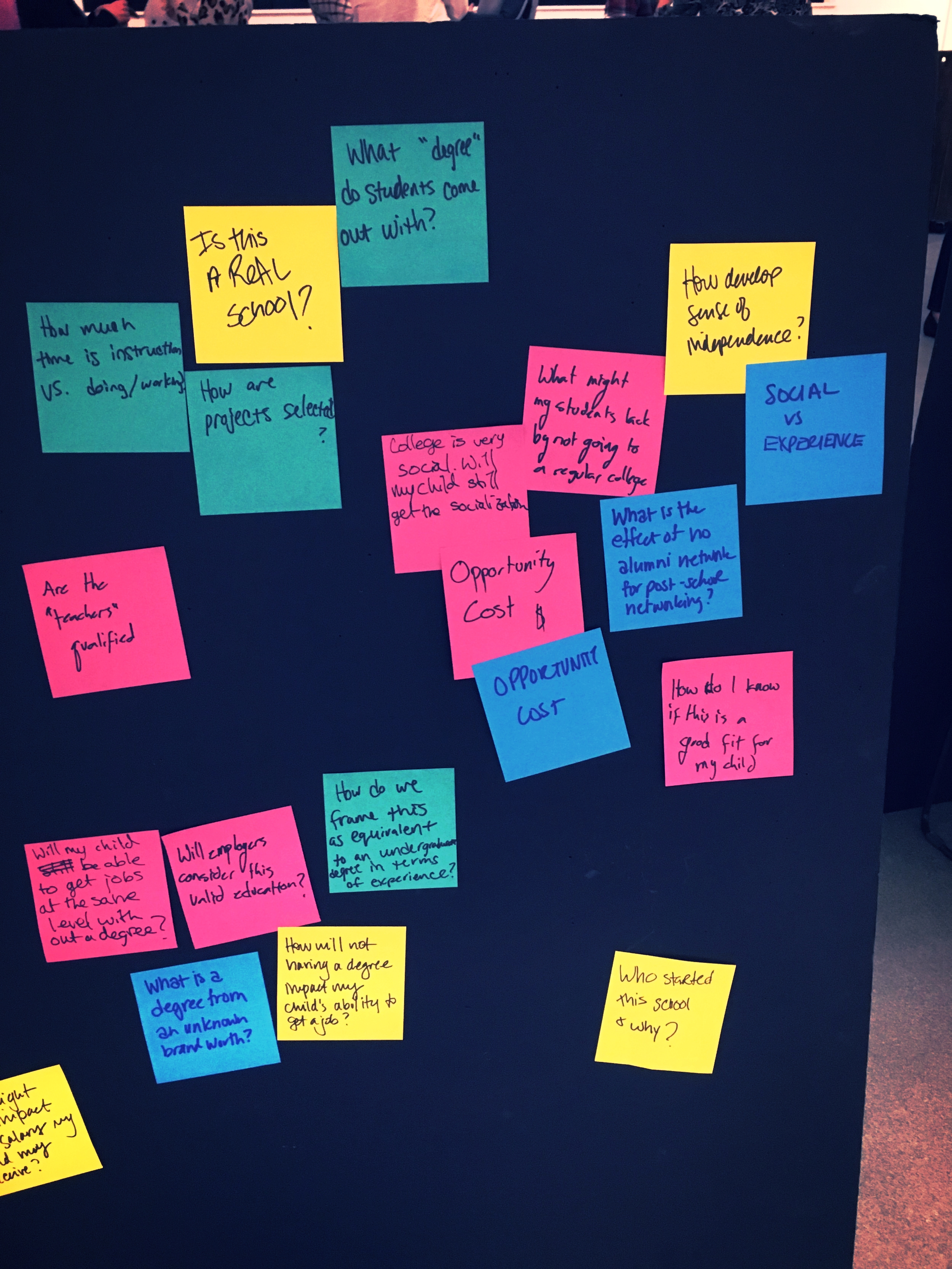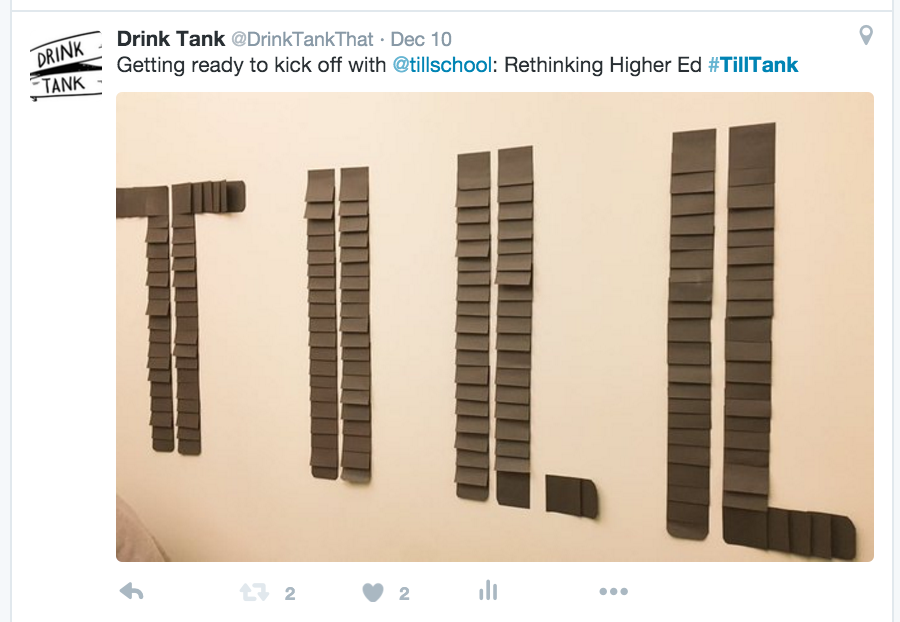Thank you for joining us last week to rethink Higher Education with Till School. Erin was right: You’re a smart bunch. We know a brainstorm isn’t useful if it stops there, so we spent some time distilling your Post-it notes, sketches and other idea shrapnel and, well that’s where you are. Welcome to the Drink Tank Impact-O-Gram: A brief recap of your ideation on behalf of Till.
HOW DRINK TANK HARVESTS THOSE mind grapes
UPDATE - Sooooo, what happened after our session? We followed up with Erin and her team six weeks after the event to understand how she internalized the feedback and prioritized the insights from our Session Notes. Here’s how things netted out, and where they are headed next:
Staff/Community:
Erin hired a candidate who had been considering contracting with the Till School but really understood the school and its mission after the Drink Tank event.
Based on board member feedback, the Drink Tank session helped members feel included, more clear on ways to to plug in, and engaged with and excited by the 2016 vision. We’re glad to hear it.
Programming:
Based on the feedback Till will host classes at night (6-9pm) in order to recruit and retain the best adjunct faculty.
Mentorship: In their sketch, the team presented mentors as resources to guide work experience throughout the program. As a result, Till will be reframing this role, incorporating this more holistic approach to mentorship.
Marketing/Messaging/Recruiting:
Till School team learned that there’s more they can do to help differentiate and qualify the students when they enter the workforce. They are creating a toolkit to help employers understand their skill set and know how students can be useful and productive.
The Till School team is a creating a new brochure and the messaging is all about gaining professional experience right away (not competing with colleges but by contrast, offering something entirely different).
Till School will be revamping digital and written communications to better define “design portfolio”, and communicate its value in the industry in order to compel parents and demonstrate educational and experiential value.
The staff has undergone a process of redesigning the website. Based on Drink Tank event feedback they are prominently introducing “meet a mentor” on the website humanize, add personalities and testimonials, and facilitate meetings with mentors and parents. All of this is aimed at making the experience real and relatable to prospective students and parents.
About the Launch Pad with Till School -
Last month we visited Erin to learn more about Till, her work and the work ahead. We read through previous research and materials in order to define the challenge statements/team tracks. Our goal was to build upon the momentum from previous Till gatherings and brainstorms and to help kickstart conversations that put your perspective and expertise to good use. The outputs of those discussions are summarized below.
The Challenge: Often students graduate without work experience or the real world skills necessary to succeed in the workforce. What can Till teach to better equip students?
Collaboration Goals: Identify the most important skills for junior communications designers today and list the ways in which Till’s curriculum might help to reinforce these skills.
The Process: Through a series of brainstorm exercises, team members identified critical skills, articulated what the absence of these skills looks like, and prototyped ways to provide valuable learning experience.
The Results: Cats are Jerks.
It turns out that storytelling is critically important for communications designers. It also turns out that storytelling about cats can be extremely compelling. See, without effective storytelling, “Cats are jerks”. With effective storytelling, “Cats are jerks because they get bored when they’re home alone.” Till has the opportunity to teach students to become effective communicators.
Big Ideas & Opportunities:
- Communications designers must be able to connect with clients and communicate their ideas effectively and succinctly.
- Courses on branding, brand positioning, psychology, or even drama could be helpful. Students should learn how to do user research to better understand audiences and gain empathy.
- One idea raised is to choose a book and have students design a scene from it (for example, design the factory from “Charlie and the Chocolate Factory”).
- Coach students with eye contact, vocal communication and being “present” while presenting.
Problem Statement: Useful educational experiences cannot exist solely within the classroom. How can Till explore, leverage and partner with the city to expand its educational mission?
Collaboration Goals: Help identify ways to blur the line between campus and community by providing Till students with experiences that will:
- Advance an understanding of what it means to be a designer
- Promote exploration within various work environments
- Deepen camaraderie and collaboration among students (and teachers)
- Establish community and corporate partnerships that differentiate Till as a school
We encouraged this team to storyboard an excursion and report back with their ideas.
The Result: Keep your eyes wide open.
This team demonstrated how students might learn and practice essential design skills in unconventional situations. They took us through a sketch in a chaotic pizza shop to demonstrate ways to teach students to identify problems through observation and interviews.
Big Ideas & Opportunities:
The team had these takeaways for excursions:
Put designers in non-design environments. Rather than sending them to agencies and creative firms, help them solve other problems where they might actually get more hands-on experience.
Make it as ambiguous and real world as possible. Don’t overly structure the experience.
Put advisors on both ends of the experience. Offer mentorship opportunities to more junior talent in partner companies and provide mentors from the advisory board in order to ensure that the Till brand is held up consistently.
Till Ventures would be a way for students to propose their own side projects and entrepreneurial initiatives.
Consider changing it from “work study” to “internship” (a term more familiar to students and parents).
The Challenge: The new and unfamiliar can be scary, or even threatening. How can students, teachers and administrators best communicate the value of Till School to parents?
Collaboration Goals: Identify channels, content and messages that might positively influence the decision-making process for parents.
The Result: Friends. What’s gonna happen with that?
This team presented two parents researching Till online. The parents wanted to know about the implications for a social life (“Friends, what’s gonna happen with that?”) and understand what their daughter’s job prospects would be after graduation. Student testimonials showed how Till’s social atmosphere is “non-traditional”, not “nonexistent”. Testimonials also underlined the value of graduating with a portfolio that puts Till students years ahead of their peers.
Also, it turns out it’s possible to act out the Internet. Well done, folks.
Big Ideas & Opportunities:
Virtual Tour/Day in the Life: Help people visualize the life on campus and as a student.
Testimonials and videos of real students and teachers help earn trust and play an important role in the decision-making process. Specifically, share videos of students articulately discussing their work and experience at Till. The social experience is important, and testimonials should also help underscore that Till students build both strong friendships and strong networks.
“Till is not in competition with 4 year institutions, but with what people project and expect that experience to be like.”Take this as opportunity to educate your target audience on the downsides of traditional college experiences (debt, for example) and share how Till is a less risky alternative.
Never let your audience underestimate the power of a portfolio. Demonstrate the value of a degree: Make it clear what kinds of jobs students can get, share real world stories, sample student work and quotes from companies about the Till students they’ve encountered.
The Challenge: Sometimes the people who would make the most amazing teachers don’t see themselves that way.
Collaboration Goals: Gain insight into the obstacles and motivations of prospective teachers in order to assist Till’s recruiting efforts.
The Results: It’s like a Butterball Hotline.
This team defined 5 major questions/”barriers to entry” for teachers as they progress.
What is Till? I’ve never heard of it.
Till is a 2 year program for postgraduate students, looking for professionals who are interested interested in working with 18 and 19 year oldsAm I skilled enough at my day job to teach?
Till will help translate your expertise into a curriculum so that you’re not just an expert, you're an expert who also knows how to work with kids.Will I be any good at teaching?
Indeed! Till will equip you with the tools and assistance needed. We recognize that teaching in itself is a craft and that it’s different from your area of expertise, but we’ll help you along the way. Think of it like a kind of Butterball hotline, where instructors can consult one another and get advice and support on a regular basis.Will I be any good at teaching 18-19 year-olds?
It’s true students this age can be “psychotic” but Till will help you learn to empathize/anticipate these students’ unique perspectives. You’ll be great.Will I be able to manage teaching with other demands?
Teaching with Till is a good investment because of the opportunity to learn and connect with a network of “equally awesome” instructors/designers in different industries, and develop your own skills in the process. Plus, you’ll be well compensated for this work.
Big Ideas & Opportunities:
Teaching is a craft, and a different skill than your area of expertise. Till will help guide new teachers throughout the process by providing support and answers-on-demand. Help prospective teachers overcome imposter syndrome and recognize that they have skills to contribute.
- If you’re talented to be a Till educator, you’re probably a well wanted resource in other areas (family, high-pressured job, etc.) Communicate what the teacher will get in return for his/her investment beyond monetary compensation.
What’s a Wild Card? Drink Tank is smart enough to get out of the way when there is a group as creative as the one that assembled last week. To that end, one group bravely struck out on their own to design their own team track.
Challenge Statement: How do you teach students it’s ok to fail?
The Results: Failure is hard…but mindfulness helps.
The team guided us through a meditation to practice mindfulness and explained that this group of Till students will probably fail for the first time. And that’s hard. Till has the opportunity to help student set goals while helping them separate themselves from their work.
Big Ideas & Opportunities:
Mindfulness teaches us that we are not our thoughts. (Spoiler alert: That is probably the biggest idea there is.) Students at Till will have to learn to put their heart and soul into their work, but also to accept critique and understand ultimately that they are not their work. Yoga and mindfulness are two ways to practice this mental resilience.
cheers!
More thoughts or ideas you want to share with Erin? She’d love to hear from you. Go ahead end her an email: erin@tillschool.com twitter: @tillschool
Questions for us? We’d love to hear from you too, and we’re easy to reach: kate@drinktankthat.com or annie@drinktankthat.com / @drintankthat
Till School
Drink Tank
Collaborators
Keep the brainstorms going! (If you participated and we've left out your LinkedIn information below it wasn't on purpose-- please send an email to cheers@drinktankthat.com and we will make the update.





























































